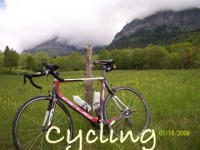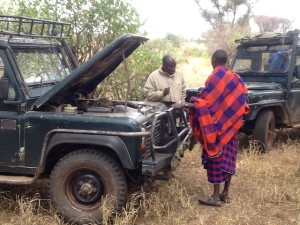
What is a “Walking Safari?” Heck, for that matter, what is a safari? Those were our questions, too.
It turns out to be a lot of driving around in Land Rovers on very rough two-tracks. I use “Land Rover” (Jaguar/Tata) generically as there are as many or more “Land Cruisers” (Toyota) bouncing around in the bush. It was six days before our Rover wheels saw more than a km of paved road. The options usually came down to 1-1/2 lane gravel, with ruts and wash-board, or 1 lane dirt with deeper ruts but no washboard. The ride recalls being caught in a Bounce House at a 10 year old’s birthday party. Dust fills the fabric of one’s shirt and pants and makes them stiff–although it helps to be in the lead Rover. We often don’t notice, though, because we are so intently viewing our surroundings.
To our surprise, in all the national parks you HAVE to stay inside your vehicle for your own safety. No hiking. Except you can hire a park ranger with a big game rifle to guide you on a predetermined hike. We’ve gotten around this by spending 2 days on the Maasai Steppe which is not a National Park or Conservation Area but is owned exclusively by Maasai tribes. Mark Thornton and a couple other safari outfitters have a special paid arrangement with a Maasai village to visit and camp there. On other occasions, we’ve paid the park fees for a local ranger to accompany us.
“Game drives” are a major component of the safari experience. In fact, they are the only component of most safaris. Like “cattle drives”, you get to see a lot of animals, but unlike cattle drives, you don’t drive the animals anywhere. Instead, you drive around in the safety of your Land Rover with your head sticking through the roof scanning the landscape for big game (and, in our case, birds). The Land Rover has to stay strictly on pre-defined two-tracks or rough gravel roads within
the parks.
After a while, you get pretty good at spotting and identifying zebras and wildebeests and warthogs, but you rely on your sharp-eyed guides for key discoveries like lions, rhinos and crested cranes. Our guides are animal encyclopedias. In fact, they have many details you won’t find in an encyclopedia, such as Chagamba’s description of a wildebeest as “the animal God made with leftover parts–head of a buffalo, shoulders of a zebra, legs of a gazelle and tail of a horse!”
Most of the time we’ve seen few if any other safari vehicles. But one of the odder experiences occurs in the most visited areas like Ngorongoro Crater, on the road to Serengeti, where 100 safari vehicles will be cruising around in the 30 square mile caldera. A star sighting (a lioness with cubs, a rhino) results in a Rover convention
and traffic jam with lots of cameras attached to swiveling heads poking out the top of the vehicles. It’s usually worth it, though.
As for the walking part, well, we really don’t walk a lot, maybe 2 hours a day, and slowly at that. A number of the group are birders and birds are everywhere. Plus there are lots of animal tracks, poop piles and small critters to note, and our guides are constantly educating us. Walks, we’ve learned, add more time to talk and explore the overall ecology of the African bush. But we also have learned that if you want to see the big game and get in close, you need to be in a vehicle.











Love it. Very interesting info. Photos excellent. Thank you. from your armchair traveling neighbor!